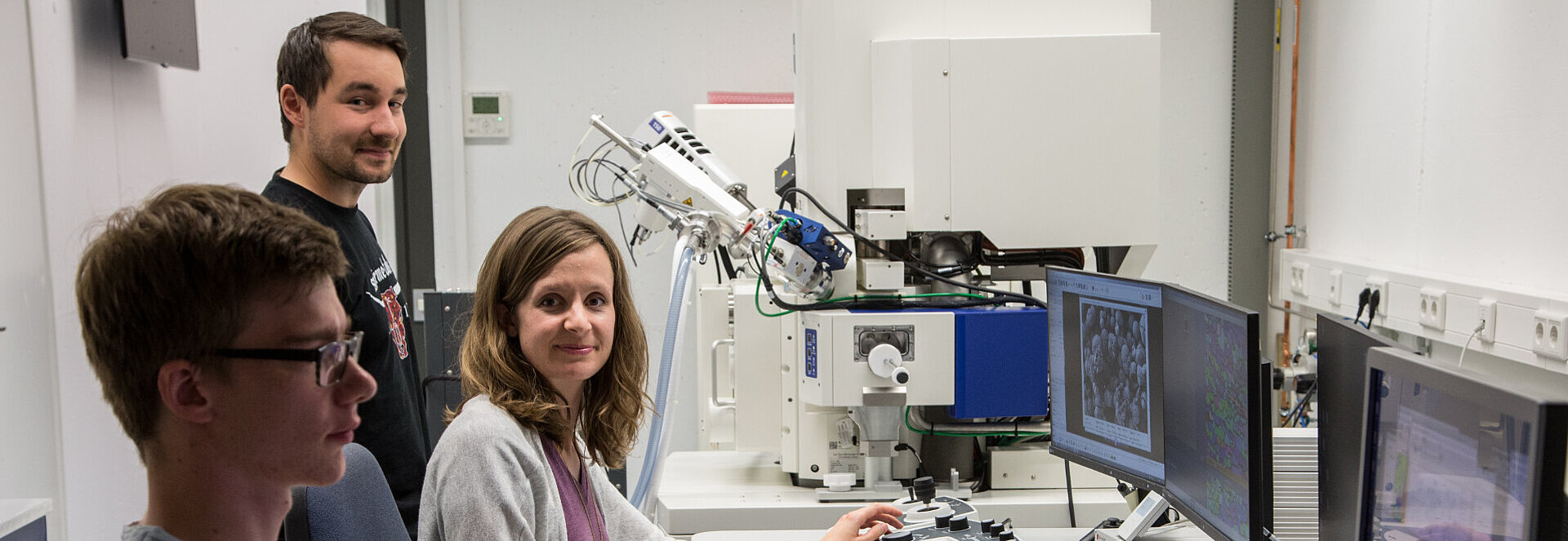Inside the Fundamental Materials Properties Institute
In the lab of the Department of Materials Science, Dr. Chandra Macauley carefully prepares the material sample. She immerses it in liquid nitrogen, causing the contents within to freeze immediately at around -190 ⁰C. At this cryogenic temperature, Macauley examines the sample using FIB-SEM tomography, an imaging technique that combines a focused ion beam (FIB) with a scanning electron microscope (SEM): using two beams, an ion beam and an electron beam, a 3D reconstruction of the specimen can be generated.
Chandra Macauley is a postdoctoral researcher at Friedrich-Alexander-Universität Erlangen-Nürnberg (FAU) and conducts research on hydrogen fuel cells and catalysts. Fuel cells convert chemical energy into electricity through an electrochemical reaction between hydrogen and oxygen. Unlike batteries, however, a fuel cell requires a continuous fuel source to sustain the reaction. “If we can better understand and tailor the structure of fuel cells, we can also improve their performance,” explains Macauley.


Passionate about Energy Research
Since her first experience of a big city—she grew up in Montana—Macauley has been interested in energy research, thinking there must be a better, cleaner means of transport. However, her academic career didn’t start with energy research. Instead, she studied chemical engineering at Montana State University: “I felt it would open up more diverse career opportunities than a degree in another engineering discipline.”
But during her studies, she was drawn to energy research. “I realized that many problems in energy research are related to material science,” says Macauley. She chose to pursue a program in energy engineering during her year abroad in Västerås, Sweden. She then applied successfully for a PhD program in material science at the University of California, Santa Barbara—one of the best programs in this field. There, she researched high temperature ceramics used in jet engines—an entirely new field for her. “Getting into a new area was challenging. It was definitely a steep learning curve, but I like to be flexible and adaptable. I think it’s a much needed quality these days.”
I think the best research happens in interdisciplinary teams where people contribute knowledge from different fields and backgrounds.Dr. Chandra Macauley, Postdoctoral Researcher at FAU
Materials Sciences at FAU
After obtaining her PhD, she jumped at the opportunity to live in Europe again. She moved to Germany to join the material science department at FAU: From previous projects she knew Dr. Peter Felfer, Chair of General Material Properties, and Dr. Kyle G. Webber, Chair of Glass and Ceramics at FAU who both told her about the great opportunities FAU offers young researchers. “I wanted to move abroad and expand my research experience to new areas,” she explains. “FAU was a great choice for me because it has excellent research facilities and I get to work with experts in their respective fields,” she adds.
At FAU, she has access to the most advanced technology for analyzing the chemical composition and structure of materials. She also has the opportunity to cooperate with a variety of research groups across disciplines. “Among other collaborative partners, we work closely with the Helmholtz Institute Erlangen-Nuremberg. As a result, there are always interesting challenges to solve through research,” says Macauley.

Material Sciences at FAU
Research Areas
Through the close cooperation between different disciplines, materials science research at FAU addresses in particular challenges in the fields of mobility, energy, and life science. Specific research areas include:
- mechanical properties of structural materials
- fundamental aspects of novel processing techniques
- surface science and technology of materials, electrochemistry, surface analysis, corrosion, micro- and nanostructuring
- polymer structure and processing, silicones, polymeric structures for biomedical applications, organic materials for electronic device applications
- materials for renewable energies and renewable electricity generation
- developing nanostructured biomaterials for medical implants, tissue engineering and drug delivery
State-of-the-Art Equipment
- Titan Themis 300: transmission electron microscope (can image single atoms and their bonds)
- ion surface fining machine
- selective electron beam machine: additive manufacturing of metallic materials
- solar cell aging simulator
- aerosol deposition chamber: production of ceramic films
- polymer fiber spinning plan:t industrial production
National and International Collaboration
- Collaborative Research Centers (CRCs): FAU coordinates eight interdisciplinary research projects and is involved in five others. The Department of Materials Sciences is involved in 6 CRCs
- The department offers several national and international doctoral programs, the latest IGK 2495, “Energy Conversion Systems: From Materials to Device" : a collaboration between FAU´s Department of Materials Sciences and the Nagoya Institute of Technology Japan
- Several EU (Horizon 2020) and ERC projects
Open to New Challenges
In the near future, she wants to focus on developing more collaborations and to continue working on application-focused research. For example, she co-organized an atom probe workshop that offered young and experienced researchers a thorough introduction to the physical fundamentals of atomic probe tomography, sample preparation and data reconstruction and interpretation. In addition, there were parallel practical sessions that allowed the participants to produce their own samples, to carry out measurements and to reconstruct their data. Furthermore, the seminar opened up a good opportunity for young scientists to get into contact with experienced colleagues of the atom probe community, thus furthering the international exchange.
Getting into a new area was challenging. It was definitely a steep learning curve, but I like to be flexible and adaptable. I think it’s a much needed quality these days.Dr. Chandra Macauley, Postdoctoral Researcher at FAU
“For one, I think the best research happens in interdisciplinary teams where people contribute knowledge from different fields and backgrounds.” Macauley continues, “The other reason is that I draw my energy from working with people. Working in a team of people to solve materials issues that are important to society is my ultimate goal. And while new challenges are something I definitely won’t shy away from, for now I am happy at FAU.”



